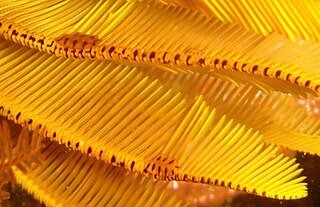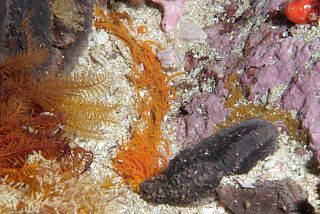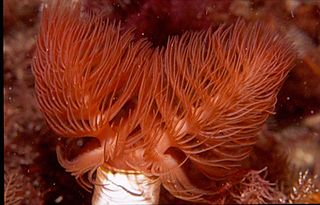
Nereididae are a family of polychaete worms. It contains about 500 – mostly marine – species grouped into 42 genera. They may be commonly called ragworms or clam worms.

Sabellidae, or feather duster worms, are a family of marine polychaete tube worms characterized by protruding feathery branchiae. Sabellids build tubes out of a tough, parchment-like exudate, strengthened with sand and bits of shell. Unlike the other sabellids, the genus Glomerula secretes a tube of calcium carbonate instead. Sabellidae can be found in subtidal habitats around the world. Their oldest fossils are known from the Early Jurassic.

Bispira brunnea, the social feather duster or cluster duster, is a species of marine bristleworm. They tend to live in groups of individuals, and are common off the Caribbean islands in southeast North America. The feather duster has one crown of various colors, however, the color of the crown seems to be consistent within individual colonies.
Schizobranchia insignis is a marine feather duster worm. It may be commonly known as the split-branch feather duster, split-plume feather duster, and the feather duster worm. It may be found from Alaska to Central California, living on pilings and rocks, intertidal to 46 m. It is particularly abundant on the underside of wharves in Puget Sound, Washington, and on wharves at Boston Harbor marina.

Serpula is a genus of sessile, marine annelid tube worms that belongs to the family Serpulidae. Serpulid worms are very similar to tube worms of the closely related sabellid family, except that the former possess a cartilaginous operculum that occludes the entrance to their protective tube after the animal has withdrawn into it. The most distinctive feature of worms of the genus Serpula is their colorful fan-shaped "crown". The crown, used by these animals for respiration and alimentation, is the structure that is most commonly seen by scuba divers and other casual observers.

A radiole is a heavily ciliated feather-like tentacle found in highly organized clusters on the crowns of Canalipalpata. Canalipalpata is an order of sessile marine polychaete worms consisting of 31 families. These benthic annelid tube worms employ radioles primarily for alimentation. While their primary role is to function as an organ for filter feeding, radioles also serve as respiratory organs. Because of their role in gas exchange, radioles are often referred to as "gills".

Sabellastarte spectabilis is a species of benthic marine polychaete worm in the Sabellidae family. It is commonly known as the feather duster worm, feather duster or fan worm. It is native to tropical waters of the Indo-Pacific but has spread to other parts of the world. It is popular in aquariums because of its distinctive appearance and its ability to remove organic particles and improve water quality.

Cirratulidae is a family of marine polychaete worms. Members of the family are found worldwide, mostly living in mud or rock crevices. Most are deposit feeders, but some graze on algae or are suspension feeders.

Eudistylia is a genus of marine polychaete worms. The type species is Eudistylia gigantea, now accepted as Eudistylia vancouveri. This worm lives in a parchment-like tube with a single opening from which a crown of tentacles projects when the worm is submerged. It is a sessile filter feeder. the Eudistylia Vancouveri is unique because it has an opiculum which makes it possible to fully retract into the tube when predators are sensed.

Eudistylia polymorpha, the giant feather duster worm, is a species of marine polychaete worm belonging to the family Sabellidae. Its common name is from the crown of tentacles extended when the animal is under water.

Serpula vermicularis, known by common names including the calcareous tubeworm, fan worm, plume worm or red tube worm, is a species of segmented marine polychaete worm in the family Serpulidae. It is the type species of the genus Serpula and was first described by Carl Linnaeus in his 1767 12th edition of Systema Naturae. It lives in a tube into which it can retract.

Diopatra is a genus of polychaete worms in the family Onuphidae.

Myzostoma fuscomaculatum, the crinoid worm, is a species of marine worm in the family Myzostomida.

The elegant feather star is a species of crinoid in the family Tropiometridae.

Cirriformia capensis, commonly known as the orange thread-gilled worm, is a species of marine polychaete worm in the family Cirratulidae.
Cirriformia tentaculata, is a species of marine polychaete worm in the family Cirratulidae.

Sabellastarte is a genus of marine polychaete worms in the family Sabellidae.

Sabella spallanzanii is a species of marine polychaete worms in the family Sabellidae. Common names include the Mediterranean fanworm, the feather duster worm, the European fan worm and the pencil worm. It is native to shallow waters in the northeastern Atlantic Ocean and the Mediterranean Sea. It has spread to various other parts of the world and is included on the Global Invasive Species Database.

Protula bispiralis, commonly known as the red fanworm or as a mopworm, is a species of marine polychaete worm in the family Serpulidae.

Poecilochaetus serpens is a species of marine polychaete worm in the family Poecilochaetidae. It is a benthic worm that burrows into soft sediment.














